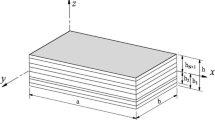Abstract
In this paper, an accurate and efficient C0-type third-order global–local model incorporating effects of the transverse normal strain is proposed to study the thermal/mechanical behaviors of thick multilayer cross-ply plates. Transverse displacement is assumed to be a linear distribution through the thickness direction, for which the normal strain could be readily computed. Based on the interlaminar continuity conditions of in-plane displacement and transverse shear stresses, layer-dependent variables could be reduced. Employing shear stress free condition at the upper and the lower surfaces, derivatives of transverse displacement are eliminated from the displacement field, so that C0 interpolation functions are only required for the finite element implementation. As a result, the number of variables is independent of the number of layers of the laminate. To assess the proposed model, the classical quadratic eight-node isoparametric element is used for the interpolation of all the displacement parameters defined at each nodal point on the composite plate. Comparing with various existing composite plate models, it is found that simple C0 finite elements with non-zero normal strain could produce accurate deformations and stresses of thick multilayer composite plates subjected to thermal and mechanical loads.
Similar content being viewed by others
References
Whitney JM, Sun CT (1973) A higher-order theory for extensional motion of laminated composites. J Sound Vib 30: 85–97
Reddy JN (1984) A simple higher-order theory for laminated composite plates. J Appl Mech 51: 745–752
Krishna MAV, Vellaichamy S (1987) On higher order shear deformation theory of laminated composite panels. Compos Struct 8: 247–270
Kant T, Swaminathan K (2002) Analytical solutions for the static analysis of laminated composite and sandwich plates based on a higher order refined theory. Compos Struct 56: 329–344
Matsunaga H (2004) A comparison between 2-D single-layer and 3-D layerwise theories for computing interlaminar stresses of laminated composite and sandwich plates subjected to thermal loadings. Compos Struct 64: 161–177
Kulkarni SD, Kapuria S (2007) A new discrete Kirchhoff quadrilateral element based on the third-order theory for composite plates. Comput Mech 39: 237–246
Norman FKJ, Qi Y (1997) On a consistent first-order shear deformation theory for laminated plates. Compos B 28: 397–405
Rolfes R, Rohwer K (1997) Improved transverse shear stresses in composite finite element based on first order shear deformation theory. Int J Numer Methods Eng 40: 51–60
Dafedar JB, Desai YM, Mufti AA (2003) Stability of sandwich plates by mixed higher-order analytical formulation. Int J Solids Struct 40: 4501–4517
Rao MK, Scherbatiuk K, Desai YM, Shah AH (2004) Natural vibrations of laminated and sandwich plates. J Eng Mech 130: 1268–1278
Chen WJ, Wu Z (2008) A selective review on recent development of displacement-based laminated plate theories. Recent Patents Mech Eng 1: 29–44
Dafedar JB, Desai YM (2004) Stability of composite and sandwich struts by mixed formulation. J Eng Mech 130: 762–770
Rao MK, Desai YM (2004) Analytical solutions for vibrations of laminated and sandwich plates using mixed theory. Compos Struct 63: 361–373
Noack J, Rolfes R, Tessmer J (2003) New layerwise theories and finite elements for efficient thermal analysis of hybrid structures. Comput Struct 81: 2525–2538
Tahani M, Nosier A (2003) Three-dimensional interlaminar stress analysis at free edges of general cross-ply composite laminates. Materials Design 24: 121–130
Tahani M, Nosier A (2004) Accurate determination of interlaminar stresses in general cross-ply laminates. Mech Adv Mater Struct 11: 67–92
Theofanis SP, Dimitris AS (2009) Higher-order layerwise laminate theory for the prediction of interlaminar shear stresses in thick composite and sandwich composite plates. Compos Struct 87: 23–35
Di Sciuva M (1986) Bending, vibration and buckling of simply supported thick multilayered orthotropic plates: An evaluation of a new displacement model. J Sound Vib 105: 425–442
Di Sciuva M (1992) Multilayered anisotropic plate models with continuous interlaminar stresses. Compos Struct 22: 149–167
Cho M, Parmerter RR (1992) An efficient higher-order plate theory for laminated composites. Compos Struct 20: 113–123
Cho M, Oh J (2003) Higher order zig-zag theory under thermo-electric-mechanical loads combined. Compos B 34: 67–82
Kapuria S, Achary GGS (2005) A coupled zigzag theory for the dynamic of piezoelectric hybrid cross-ply plates. Arch Appl Mech 75: 42–57
Kapuria S, Kulkarni SD (2008) An efficient quadrilateral element based on improved zigzag theory for dynamic analysis of hybrid plates with electroded piezoelectric actuators and sensors. J Sound Vib 315: 118–145
Li XY, Liu D (1997) Generalized laminate theories based on double superposition hypothesis. Int J Numer Methods Eng 40: 1197–1212
Wu Z, Chen WJ (2006) Free vibration of laminated composite and sandwich plates using global–local higher-order theory. J Sound Vib 298: 333–349
Wu Z, Chen WJ (2007) Buckling analysis of angle-ply composite and sandwich plates by combination of geometric stiffness matrix. Comput Mech 39: 839–848
Oh J, Cho M (2004) A finite element based on cubic zig-zag plate theory for the prediction of thermo-electric-mechanical behaviors. Int J Solids Struct 41: 1357–1375
Wu Z, Chen WJ (2010) A global–local higher order theory including interlaminar stress continuity and C0 plate bending element. Comput Mech 45: 387–400
Wu Z, Chen WJ, Ren XH (2010) An accurate higher-order theory and C0 finite element for free vibration analysis of laminated composite and sandwich plates. Compos Struct 92: 1299–1307
Pagano NJ (1970) Exact solution of rectangular bi-directional composites and sandwich plates. J Compos Mater 4: 20–34
Rolfs R, Noor AK, Sparr H (1998) Evaluation of transverse thermal stresses in composite plates based on first-order shear deformation theory. Comput Methods Appl Mech Eng 167: 355–368
Matsunaga H (2002) Assessment of a global higher-order deformation theory for laminated composite and sandwich plates. Compos Struct 56: 279–291
Murakami H (1986) Laminated composite plate theory with improved in-plane response. J Appl Mech 53: 661–666
Brank B, Carrera E (2000) A family of shear-deformable shell finite elements for composite structures. Comput Struct 76: 287–297
Author information
Authors and Affiliations
Corresponding author
Rights and permissions
About this article
Cite this article
Lo, S.H., Zhen, W., Sze, K.Y. et al. C0-type global–local theory with non-zero normal strain for the analysis of thick multilayer composite plates. Comput Mech 47, 479–491 (2011). https://doi.org/10.1007/s00466-010-0554-5
Received:
Accepted:
Published:
Issue Date:
DOI: https://doi.org/10.1007/s00466-010-0554-5




